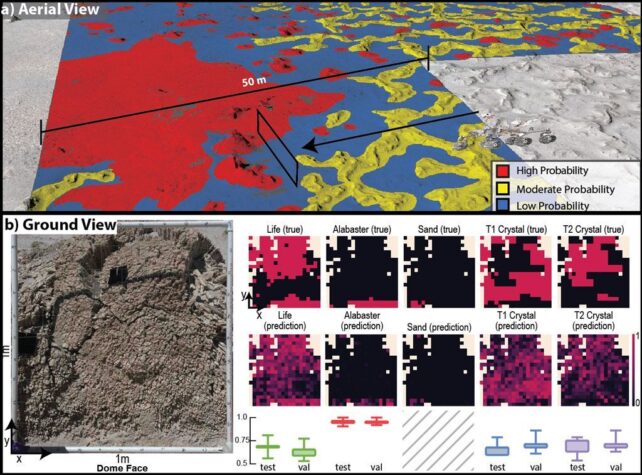It’s all well and good to talk about finding signs of life on Mars, but we also need to know where to look. It’s hard to get to Mars – we want to make sure to make the most of the opportunities available so that the trip is not wasted.
But there is a lot of ground to cover. Mars has about the same surface area of dry land as Earth, with one major difference. Throw a rock at Earth, and it’s likely to land somewhere with life. However, the history of life on Mars is a big question mark.
Artificial intelligence and machine learning could make the search for life on Mars less difficult. An international team of researchers led by astrobiologist Kimberley Warren-Rhodes of the SETI Institute has shown that these tools can identify hidden patterns in geographical data that could indicate the presence of signs of life.
“Our framework allows us to combine the power of statistical ecology with machine learning to discover and predict the patterns and rules by which nature lives and distributes itself in the harshest landscapes on Earth,” Warren-Rhodes explained.
“We hope that other astrobiology teams will adapt our approach to mapping other habitable environments and biosignatures. Using these models, we can design tailor-made roadmaps and algorithms to guide rovers through places with the highest probability of sustaining past or present life – no matter how hidden or rare.”
There is one place on Earth that bears a striking resemblance to the barren plains of Mars. That’s the Atacama Desert in Chile, one of the driest places on the planet, not seeing rain for decades. Even in this inhospitable place, life can be found hidden in pockets and underground.
Warren-Rhodes and her colleagues focused on a border region between the Atacama Desert and the Altiplano plateau called the Salar de Pajonales. This basin is an ancient riverbed and one of the best Mars environment analogs on Earth. At 3,541 meters (11,617 feet), it is high in altitude and subsequently receives high UV exposure. It’s also low in oxygen and extremely dry and salty… but somehow, life can be found there, living in mineral formations.

In an area of 2.78 square kilometers (1.07 square miles), the researchers carefully took 7,765 images and 1,154 samples, looking for telltale biosignatures that indicated the presence of photosynthetic microbes. These include carotenoids and chlorophyll pigments, which color the stone pink or green.
They also used drones to take aerial images to mimic images taken by satellites orbiting Mars and added 3D topographic maps. All this information is then entered into convolutional neural networks (CNNs) to train AI to identify structures in the basin that are more likely to be teeming with life.
And interestingly, the CNNs identified patterns in the distribution of microbial life in the basin, despite the area’s very similar mineral composition.
Domes of the soft mineral gypsum are about 40 percent occupied, and patterned ground with striped gypsum ribbons are about 50 percent occupied. By examining what parts of these features are inhabited, researchers have found microhabitats. Microbes are strongly drawn to sections of alabaster, a fine-grained, porous form of gypsum that retains water.
These alabaster microhabitats, the team found, were “almost universally populated” and represented the most reliable predictor of biosignatures, suggesting that water content is the primary driver for microhabitat distributions.
More relevant for the search for life on Mars, CNNs have allowed researchers to correctly identify biosignatures up to 87.5 percent of the time, compared to up to 10 percent for random searches. This reduced the amount of land they had to cover by a whopping 85 to 97 percent.
frameborder=”0″ allow=”accelerometer; auto-play; clipboard-write; encrypted media; gyroscope; picture-in-picture; web-share” allowfullscreen>
“For both aerial images and ground-based centimeter-scale data, the model showed high predictive ability for the presence of geological materials likely to contain biosignatures,” said computer scientist Freddie Kalaitzis of Oxford University in the UK.
“The results align well with the ground-truth data, with the distribution of biosignatures strongly associated with hydrological features.”
The approach, therefore, seems to have many benefits. The work has taught us something about life in extreme environments here on Earth and shows promise for identifying life on Mars. And it may help identify other biosignatures here on Earth.
The team plans to try to train their CNNs on other biosignatures, such as stromatolites, which are fossilized microbial mats that may be billions of years old, and communities of halophiles, organisms that thrive in super-salty environment.
“Our framework allows us to combine the power of statistical ecology with machine learning to discover and predict the patterns and rules by which nature lives and distributes itself in the harshest landscapes on Earth,” Warren-Rhodes said.
“We hope that other astrobiology teams will adapt our approach to mapping other habitable environments and biosignatures. Using these models, we can design tailor-made roadmaps and algorithms to guide rovers through places with the highest probability of sustaining past or present life – no matter how hidden or rare.”
The research was published in Astronomy of Nature.
